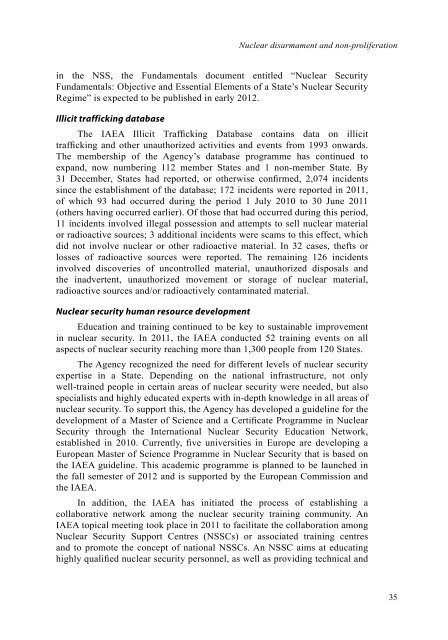DYB2011-Part-II-web
DYB2011-Part-II-web
DYB2011-Part-II-web
You also want an ePaper? Increase the reach of your titles
YUMPU automatically turns print PDFs into web optimized ePapers that Google loves.
Nuclear disarmament and non-proliferation<br />
in the NSS, the Fundamentals document entitled “Nuclear Security<br />
Fundamentals: Objective and Essential Elements of a State’s Nuclear Security<br />
Regime” is expected to be published in early 2012.<br />
Illicit trafficking database<br />
The IAEA Illicit Trafficking Database contains data on illicit<br />
trafficking and other unauthorized activities and events from 1993 onwards.<br />
The membership of the Agency’s database programme has continued to<br />
expand, now numbering 112 member States and 1 non-member State. By<br />
31 December, States had reported, or otherwise confirmed, 2,074 incidents<br />
since the establishment of the database; 172 incidents were reported in 2011,<br />
of which 93 had occurred during the period 1 July 2010 to 30 June 2011<br />
(others having occurred earlier). Of those that had occurred during this period,<br />
11 incidents involved illegal possession and attempts to sell nuclear material<br />
or radioactive sources; 3 additional incidents were scams to this effect, which<br />
did not involve nuclear or other radioactive material. In 32 cases, thefts or<br />
losses of radioactive sources were reported. The remaining 126 incidents<br />
involved discoveries of uncontrolled material, unauthorized disposals and<br />
the inadvertent, unauthorized movement or storage of nuclear material,<br />
radioactive sources and/or radioactively contaminated material.<br />
Nuclear security human resource development<br />
Education and training continued to be key to sustainable improvement<br />
in nuclear security. In 2011, the IAEA conducted 52 training events on all<br />
aspects of nuclear security reaching more than 1,300 people from 120 States.<br />
The Agency recognized the need for different levels of nuclear security<br />
expertise in a State. Depending on the national infrastructure, not only<br />
well-trained people in certain areas of nuclear security were needed, but also<br />
specialists and highly educated experts with in-depth knowledge in all areas of<br />
nuclear security. To support this, the Agency has developed a guideline for the<br />
development of a Master of Science and a Certificate Programme in Nuclear<br />
Security through the International Nuclear Security Education Network,<br />
established in 2010. Currently, five universities in Europe are developing a<br />
European Master of Science Programme in Nuclear Security that is based on<br />
the IAEA guideline. This academic programme is planned to be launched in<br />
the fall semester of 2012 and is supported by the European Commission and<br />
the IAEA.<br />
In addition, the IAEA has initiated the process of establishing a<br />
collaborative network among the nuclear security training community. An<br />
IAEA topical meeting took place in 2011 to facilitate the collaboration among<br />
Nuclear Security Support Centres (NSSCs) or associated training centres<br />
and to promote the concept of national NSSCs. An NSSC aims at educating<br />
highly qualified nuclear security personnel, as well as providing technical and<br />
35


